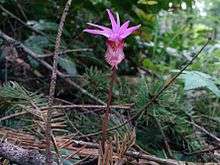Calypso bulbosa
Calypso is a genus of orchids containing one species, Calypso bulbosa, known as the calypso orchid, fairy slipper or Venus's slipper. It is a perennial member of the orchid family found in undisturbed northern and montane forests. It has a small pink, purple, pinkish-purple, or red flower accented with a white lip, darker purple spottings, and yellow beard. The genus Calypso takes its name from the Greek signifying concealment, as they tend to favor sheltered areas on conifer forest floors. The specific epithet, bulbosa, refers to the bulb-like corms.[2]
| Calypso bulbosa | |
|---|---|
 | |
| Scientific classification | |
| Kingdom: | Plantae |
| Clade: | Tracheophytes |
| Clade: | Angiosperms |
| Clade: | Monocots |
| Order: | Asparagales |
| Family: | Orchidaceae |
| Subfamily: | Epidendroideae |
| Tribe: | Calypsoeae |
| Genus: | Calypso Salisb. |
| Species: | C. bulbosa |
| Binomial name | |
| Calypso bulbosa (L.) Oakes | |
| Synonyms[1] | |
| |
Description
Calypso orchids are typically 10 to 14 cm in height.[2] Their bright pink blooms can be a pleasant sporadic sight on hiking trails from late March onwards, though in the more northerly parts of their range they do not bloom until May and June. The plants live no more than five years.[2]
This species' range is circumpolar,[3] and includes California, the Rocky Mountain states and most of the most northerly states of the United States; most of Canada; Scandinavia much of European and Asiatic Russia; China, Mongolia, Korea and Japan—see external links for map.[1][4]
Although the calypso orchid's distribution is wide, it is very susceptible to disturbance, and is therefore classified as threatened or endangered in several U. S. states and in Sweden and Finland. It does not transplant well[2] owing to its mycorrhizal dependence on specific soil fungi. The corms have been used as a food source by North American native peoples. The Thompson River Indians of British Columbia used it as a treatment for mild epilepsy.[5]
At least near Banff, Alberta, the calypso orchid is pollinated by bumble bees (Bombus (Pyrobombus) and B. Psithyrus). It relies on "pollination by deception", as it attracts insects to anther-like yellow hairs at the entrance to the pouch and forked nectary-like structures at the end of the pouch but produces no nectar that would nourish them. Insects quickly learn not to revisit it. Avoiding such recognition may account for some of the small variation in the flower's appearance.[4][6]
Varieties
Four natural varieties and one nothovariety (variety of hybrid origin but established in the wild) are recognized:[1]
- Calypso bulbosa var. americana (R.Br.) Luer - most of Canada, western and northern United States
- Calypso bulbosa var. bulbosa - Sweden, Finland, Baltic States, much of Russia, Mongolia, Korea
- Calypso bulbosa nothovar. kostiukiae Catling - Alberta (C. bulbosa var. americana × C. bulbosa var. occidentalis)
- Calypso bulbosa var. occidentalis (Holz.) Cockerell - from Alaska and British Columbia south through the Cascades, Rockies, and Sierra Nevada to California
- Calypso bulbosa var. speciosa (Schltr.) Makino - Japan, China (Gansu, Jilin, Nei Mongol, Sichuan, Tibet, Yunnan)[7]
References
- Kew World Checklist of Selected Plant Families
- Coleman, Ronald A. (2002), The Wild Orchids of Arizona and New Mexico, Nature, pp. 21–26, ISBN 0-8014-3950-7, retrieved 2009-06-27
- C.Michael Hogan, ed. 2010. Calypso bulbosa. Encyclopedia of Life.
- Boyden, Thomas C. (1982), "The pollination biology of Calypso bulbosa var. Americana (Orchidaceae): Initial deception of bumblebee visitors", Oecologia, 55 (2): 178–184, Bibcode:1982Oecol..55..178B, doi:10.1007/bf00384485, PMID 28311231
- Moerman, Daniel E. (1998), Native American ethnobotany, Timber Press, p. 133, ISBN 0-88192-453-9
- Mosquin, T. (1970), "The Reproductive Biology of Calypso bulbosa (Orchidaceae)", Can. Field-Nat. (84): 291–296 Summarized by Coleman and by Boyden
- Flora of China v 25 p 252, 布袋兰 bu dai lan, Calypso bulbosa var. speciosa
External links


- Map of distribution
- Jepson Manual treatment of the species
- Wild orchid of Japan